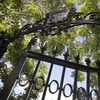* The longtime head of the Dance Office, Claire S. Mallardi, says she gave up years ago "wasting time" trying to get dance courses into the Harvard curriculum, even though "every other Ivy League college to my knowledge. . . has gone in one form or another into some form of credit for dance."
* Monroe Engel '42, director of the English Department's Creative Writing program, says. "We're not providing as much as we might" in the way of classes for students with little or no creative writing background.
Every art program at Harvard wants more funds and more teachers. But every program at Harvard wants more funds and more teachers. Why are the artists' demands any more important than anyone else's?
Aside from the merits of each request, there seems to be an underlying motive uniting the hopes of the various arts programs. They all say they want respect. (Creative writing may be all exception. Says Engel, "Students who take creative writing are not ghettoized.")
'''Arts and Letters' is the familiar formulation all over the world." says Bakanowsky, who authored the 1978 Faculty-approved guidelines on course credit for performance in the arts. "At Harvard it's 'Letters and Arts.'''
"I don't think there has traditionally been sufficient respect at Harvard for the arts," says Brustein, a theatrical director who brought the American Repertory Theater with him from Yale in 1979. "But I don't think it's an unchangeable situation. It's changed a lot in the last five years. A lot of people have discovered the awe of the arts."
But a lot of people have yet to be convinced. As Myra Mayman, director of the Office of the Arts, explains, there is a strong bias against performers as academics. "The typical comment of the critic is. 'Talk to an artist? Why? They don't know what they're doing. Mayman says.
This view has been promoted through such works as the play and film "Amadeus," according to Kirchner, which portrays the composer Mozart as "an idiot with a divine gift."
In fact, some, including Bakanowsky, have given up on this generation of non-artists. "It's well-meaning people who have not had this as part of their life experience, so they are suspicious," Bakanowsky states. "They just don't understand, and I don't think it's worth the energy to try to convince them. Focus on the next generation."
Already, Brustein says, "Harvard is beginning to attract a different kind of generation of Harvard students" more interested in the arts.
Despite Brustein's comment, of course, a lack of academic arts offerings didn't seem to deter dedicated Harvard and Radcliffe students in the past. Without University sanction, students founded the Pierian Sodality (now the Harvard-Radcliffe Orchestra), the Glee Club, and a multitude of other art performance groups.
John U. "Jack" Lemmon '47 attended Harvard, as did Frederick L. 'Grandy '70 ("Gopher" on "The Love Boat"), Susan W. Stockard-Channing '65, Frederick H. Gwynne '51 ("Herman" on "The Munsters"), John A. Lithgow '67 ("The World According to Garp"), among other actors.
Not to mention composer-conductor Leonard Bernstein '39 and cellist Yo-Yo Ma '75, writers John H. Updike '54 and Peter B. Benchley '61, poets T.S. Eliot '10 and George Santayana '99, and a multitude of others.
All this while Harvard maintained an official posture of distaste for the arts.
It was as late as the 1920s that "Discernment and the cultivation of taste, plus the scholarship of art, became the subject of proper study for gentlemen and women," writes Mayman in a recent issue of The Radcliffe Quarterly. "Making paintings was another matter."
Read more in News
Ferrell Will Run for Council President












